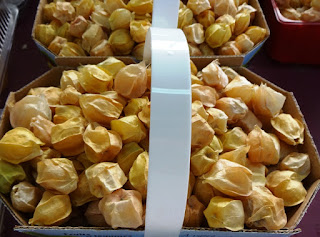At the beginning of the winter a friend, who moved to Canada from a warmer climate, called with some alarm the first day it snowed. Sure, she knew about snow. But this kept coming down and coming down, and she was watching the garden she'd planted freeze. How could her plants survive?
I explained that, except for perennials, they wouldn't. She would have to plant a new garden next spring. She thought that was ridiculous. I agree. But there it is.
A couple of weeks ago, when it was -25C and the city hadn't cleaned the sidewalks yet and going for a walk meant floundering and slipping through snow, I decided what to plant in my garden this year. Ordering packets of seeds
even though there's still snow on the ground, feels like an existential, yet necessary exercise.
Understand what I'm saying here: I'm not even a very good gardener. I do it for the idea--and the taste of what I do manage to harvest. I believe, too, in eating what's grown locally.
I don't even live all that far north in Canada, but most of the vegetables and fruit I buy from November until the first harvest the following summer is imported. Fruit has often been picked unripe so it can be shipped thousands of kilometres to get here. How can you compare asparagus from Peru versus asparagus cut less than an hour's drive away?
Last September I took pics at the Jean-Talon market. What a wealth!

When I was growing up, we ate buttered bread with sliced radishes on top. It made for a crisp, peppery sandwich.
At the market, some stalls had a cauldron of boiling water and a bowl of melted butter for cobs on the go.
My father-in-law once told me that Shepherd's Pie was invented in Quebec. Not true, I know, but his rationale was that in Quebec we had beef, corn, and potatoes. Shepherd's Pie was the dish that resulted. He had no explanation for why it also had an English name. He called it Pâté Chinois which translates as Chinese Pie. I think that has to do with the dish being layered. Instead of meat, veg, and starch being served in distinct piles on the plate, it's mixed. For a rural mindset, that means it's exotic. I base that linguistic deduction on experiences in my own family where food that was tossed or layered or mixed was considered to be weird.
I never saw ground cherries before moving to Quebec. Here, they're popular. You can buy them in a regular grocery store. They taste like a mixture of tomato, mango, and...? They taste almost too tropical to grow in Canada.
Cauliflower comes with a flower in its name, but this was the first time I ever saw it sold in bouquets.
In my garden, I'll be planting lettuce, green beans, arugula, tomatoes, snow peas, parsley. I keep it simple. With luck my rhubarb fared well this past winter and will be there again once the snow has melted.























